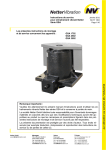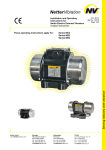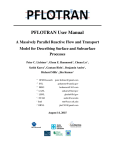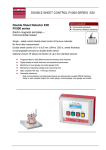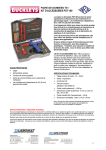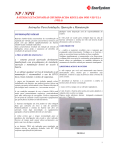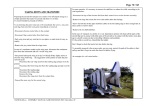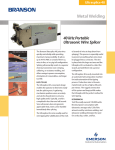Download Operating Instructions for Netter Vibration Drive Series GSA These
Transcript
Operating Instructions for Netter Vibration Drive Series GSA These operating instructions apply to: Jan. 2012 BA No. 1264 Page 1/20 GSA 1702 GSA 2502 GSA 3502 Important note: Before use of the Netter vibration drives of the series GSA read these operating instructions carefully and keep them stored afterwards. Netter GmbH does not assume liability for damage to property and persons if the product has been technically modified or if the notes and regulations of these operating instructions have not been observed. This documentation is copyrighted. All rights, e.g. for translation into other languages, reprinting and copying of these operating instructions or parts hereof remain strictly reserved. Contents 1 GENERAL NOTES 3 2 TECHNICAL DATA 4 3 DESIGN AND FUNCTIONING 5 4 SAFETY 6 5 TRANSPORT AND STORAGE 8 6 INSTALLATION 9 6.1 Mounting of the vibration drive 9 6.2 Assembly of the encoder 10 6.3 Electrical connection 10 7 START-UP 12 8 MAINTENANCE / REPAIR 13 9 TROUBLESHOOTING 15 10 SPARE PARTS 16 11 APPENDIX 16 11.1 Accessories 16 11.2 Disposal 16 11.3 Enclosures 16 Scope of supply Check the packing for possible shipping damage. If the packing is damaged, check the contents for completeness and possible damage. In case of damage inform the transport agent. Compare the scope of supply with the delivery note. . 2 1 General Notes Netter vibration drives of the series GSA comply with the EC Machinery Directive 2006/42/EC, the Directive 2004/108/EC relating to electromagnetic compatibility and the Low Voltage Directive 2006/95/EC. In particular the standards DIN EN ISO 12100, DIN EN 60529 and EN 60034-1 have been observed. Vibration drives vibrations. generate They can also be used in the food and chemical industry if the respective operating regulations of the user are complied with. Special features: • 100% duty cycle • Protection type IP 65 • Insulation class F • High efficiency due to silicon electric sheets • Minimal installation dimensions • Noise level ≤ 70 dB(A) • Fitted with thermistor as a standard • Earthing screw in the terminal box circular These vibration drives are used in Netter dóêçShake shaking stations and shaking tables. Shaking stations of the series dóêçShake are used for concrete compaction in pre-cast part manufacturing plants. Shaking tables loose, separate and distribute bulk material and mix liquids into emulsions and suspensions. In these operating instructions the following information and danger symbols are used: DANGER points out a possible danger which might result in death or serious injury if not avoided. CAUTION points out a possible danger which might lead to personal injury or equipment damage if not avoided. HOT SURFACE points out a possible danger which might lead to personal injury or equipment damage if not avoided. IMPORTANT Note containing especially useful information and tips. ENVIRONMENTALLY points out the obligation to dispose of waste in FRIENDLY WASTE an environmentally friendly way. DISPOSAL 3 2 Technical Data Nominal voltage, nominal frequency: The use of a frequency converter is mandatory for the operation of the vibration drives! Voltage and frequency as specified on the type plate. Power supply with frequency converter: At constant torque (linear Volt-Hertz curve) the frequency converter may regulate the frequency between 0 Hz and 50 Hz Type GSA 1702 0 Hz and 38 Hz Type GSA 2502 0 Hz and 34 Hz Type GSA 3502 (Observe maximum frequency on the type plate). It must be ensured that the EMC Directive is complied with. The operation of vibration drives of the series GSA with frequency converters permits variable speeds. IMPORTANT Rotary speed ranges: Type GSA 1702 Type GSA 2502 Type GSA 3502 maximal 750 rpm maximal 580 rpm maximal 510 rpm The maximum speeds indicated on the type plate must not be exceeded. Ambient temperature: 0°C to +40°C The ambient temperatures must not be exceeded or fallen below. These values apply to operation with a duty time of 100%. Vibration drives must not be used in hazardous areas. Thermal overload protection: GSA vibration drives are fitted with a PTC thermistor 130°C as a standard. Type GSA 1702 GSA 2502 GSA 3502 Nominal frequency [Hz] 50 38 34 Max. speed [min-1] 750 580 510 4 Unbalance [cmkg] 1.622 2.698 3.500 Centrifugal force [N] 50.000 50.000 50.000 The technical data of your vibration drive can be seen on the type plate. Type designation Duty time Rotary speed Centrifugal force Voltage Frequency Current Phases Power Insulation class Manufacture year Protection type Serial number Max. ambient temp. For detailed technical data on the vibration drives see the Technical Data Sheets in the middle section of this operating manual. 3 Design and Functioning • The vibration drive of the series GSA is an asynchronous motor. • The motor shaft is made of heat treated alloy steel. − The stators of the asynchronous motors are made of electrical sheet with a low dissipation factor in order to achieve a high efficiency at a low operating temperature of the motor. • The special bearings are overdimensioned for excessive loads − Motor protection thermistor. • The housings are made of strength lamellar graphite cast. by • Rotary speed regulation with frequency converters is mandatory for all units. incorporated high • The paint finish is highly weatherresistant as well as resistant to abrasion, impacts and a wide variety of chemicals. Colour: traffic black. • The unbalance masses separated from the drive. 5 can be 4 Safety Voltage-carrying or rotating parts can cause severe or fatal injuries. DANGER DANGER The vibration drives are manufactured in accordance with the current EC directives. Assembly, installation, commissioning and maintenance must only be performed by authorized qualified personnel. During installation and operation of the vibration drives the directives and regulations of the local associations for electrical engineering (e.g. VDE) and the known accident prevention rules have to be complied with. Changes to the device may affect the characteristics or even damage the unit and cause the rejection of any warranty claims. CAUTION When working on the vibration drive it has to be safely disconnected from the power supply. To do this, proceed as follows: 1. Switch off vibration drive DANGER 2. Secure against being switched on again 3. Check for the absence of voltage Use a suitable supply cable for the installation. Connect cables and protective conductors correctly. DANGER IMPORTANT Circuit diagrams can be found in the terminal box (see chapter 6.2 Electrical connection). The ends of the leads must be fitted with insulated cable clips to prevent the strands from splaying. The maximum size of the cable clips is AWG 16 for set screw M5. The electric cables have to be installed carefully and it has to be ensured that the cables are not worn through by vibrating parts. The proper condition of the electric cables and the cable clips has to be checked at regular intervals (as a rule every six months). Discovered DANGER faults have to be immediately eliminated. Protect the cable against high temperatures, lubricants and sharp edges. 6 DANGER DANGER HOT SURFACE GSA vibration drives and other parts of the structure may come loose due to vibration. Falling parts can cause injuries or damage to material. Screw locks and/or Loctite or the like have to be used. Screw connections have to be checked and possibly retightened after 1 hour of operation and then at regular intervals (as a rule once a month). The vibration drive must not be operated without unbalance cover! The rotating unbalances can cause severe injuries! The surface of the vibration drive can reach such high temperatures that there is a risk of burns. 7 5 Transport and Storage Check the packaging for possible signs of transport damages. In the event of damage to the packaging, check that the contents are IMPORTANT complete and undamaged. If there is any damage, inform the shipping agent. The units are packed ready-to-install. If it is necessary to store the vibration The type plate is fixed on the vibration drive for a longer period (up to a drive. maximum of 2 years), the temperature When transporting the vibration drive, in the storage room must not fall below it should be ensured that it is not +5°C or exceed +40°C and the relative subjected to severe impacts or vibraair humidity must not exceed 60%. tions which might damage the bearings. After a storage time of more than 1 The device should be stored in a dry year the grease in the bearing of the and clean environment. vibration drive must be exchanged before installation and the vibration drive must be tested electrically. DANGER The vibration drives must never be placed directly on the encoder and Use the transport lug in the mo- the terminal box, because the tor shaft only for lifting the vibra- encoder and terminal box would be tion drive. damaged by it. Vibration drives must always be transported standing on the flange. IMPORTANT Always place sufficiently high square timber blocks underneath the flanges when setting the vibration drive on the ground or transporting it. 8 Technical Data Sheet Type GSA 1702 750 min-1 Unbalance 1.622 cmkg Centrifugal force 50.000 N Mass 210 kg Voltage 400 V Frequency 50 Hz Nominal current 3,5 A Nominal power 2,55 kW Max. rotation speed contact surface milled flat Dec. 2011 No. 4506E Technical Data Sheet Type GSA 2502 580 min-1 Unbalance 2.698 cmkg Centrifugal force 50.000 N Mass 245 kg Voltage 400 V Frequency 38 Hz Nominal current 3,5 A Nominal power 2,55 kW Max. rotation speed contact surface milled flat May 2011 No. 4392E Technical Data Sheet Type GSA 3502 510 min-1 Unbalance 3.500 cmkg Centrifugal force 50.000 N Mass 273 kg Voltage 400 V Frequency 34 Hz Nominal current 4 A Nominal power 2,8 Max. rotation speed kW contact surface milled flat May 2011 No. 4393E 6 Installation DANGER During installation the safety instructions of chapter 4 and the accident prevention rules have to be complied with! The installation of the system must be carried out in compliance with the local known regulations (e.g. VDE regulations). 6.1 Mounting of the vibration drive Netter vibration drives can only be operated in horizontal position. The following instructions have to be strictly observed during installation: DANGER The mounting surfaces must be absolutely even (± 0,1mm evenness) so that the feet of the vibration drives are fully in contact with the surface and no tensions occur in the housing when tightening the fastening screws. There should also be no paint residues or weld penetrations on the surfaces. Tensions in the housing can lead to mechanical and/or electrical damage. It is mandatory to use fastening screws of the quality 8.8 (DIN 931 or 933) and secure them with counter nuts (DIN 934) and a suitable glue. The screws have to be checked and possibly retightened at regular intervals (generally once a month). DANGER The tightening torques can be taken from the following table. Higher tightening torques may cause fracture of screws or tearing of threads. Inadequate screw connections may cause loosening of units by vibration. This can cause injuries and damage to material! Recommended tightening torques for screws of the quality 8.8 (Screws as supplied, with no extra grease or lubrication): Screw type Torque M 24 740 Nm Use a torque wrench and tighten the screws in a crosswise pattern. Retightening: Screw connections should be retightened after 1 h of operation (after the first commissioning) and then checked at regular intervals (generally once DANGER a month) and retightened, if necessary. 9 6.2 Assembly of the encoder 1. The roll pin must be fitted exactly into the keyway of the hollow shaft. Any other position will damage the encoder! 2. The cable output of the encoder housing must show in the direction of the terminal box of the vibration drive. 3. Connect the hollow shaft with the tappet by means of the hexagonal screw M5, the Nordlock lock washer and the thrust washer (external hex profile). 4. Attach encoder by means of hexagonal screws and Nordlock lock washers. Fix screw cap to the encoder. 6.3 Electrical connection ATTENTION: The terminal box must not be opened when voltage is applied! The electrical installation of the vibration drives must only be carried out by authorized qualified personnel. DANGER The qualified personnel have to use only insulated tools that are suitable for this area of application. 10 Electrical connection Each vibration drive has to be provided with a suitable motor protection switch. For dual operation, the motor protection switches must be mutually interlocked to ensure that upon failure of one motor the power supply of both is interrupted DANGER simultaneously. Otherwise uncontrolled vibrations might occur and damage the system. Use only flexible cables for the connection of the vibration drive. IMThe ends of the leads must be fitted PORTAN with insulated cable clips to prevent the T strands from splaying. The conductors in the supply cable for connection of the vibration drive to the mains supply must have a sufficient cross section suited to the length of the cable used. The green-yellow conductor is the DANGER earthing conductor and must be used exclusively for connection to the earth terminal. When selecting the connecting cables, please consider the mechanical demands on the cables due to vibration. The recommended cable types for power supply operation with 400 V in non-explosive atmosphere: rubber hose line H07 RN-F or oilflex cable IMPORTAN 110 CY. T In case of other voltages or other environmental conditions the cables have to be adapted accordingly. The electric lines have to be laid with care. It has to be ensured that the cables are not worn through by vibrating parts. The proper condition of the electric lines and their plugs has to be checked at regular intervals (generally every six months). Defects which DANGER are discovered are to be eliminated immediately. Tighten junction plate nuts using the prescribed torque. Do not forget the lock washer between the ring and the nut and reinsert the vibration-damping element. DANGER M 4 ⇒ 3,1 Nm M 5 ⇒ 6,1 Nm M 6 ⇒ 10,4 Nm 11 Depending on the supply voltage the wiring has to be made as follows: Terminal plan The green-yellow Series GSA with thermistor Series GSA with thermistor conductor is the protective Alternating current 3-phase Alternating current 3-phase conductor and must Lower voltage Higher voltage exclusively be connected to the earth terminal. U More terminal plans (e.g. for special voltages) on request. Vibration drives must only be operated with a frequency converter IMPORTANT and it has to be ensured that the EMC directive is complied with. 7 Start-up Please comply with the safety instructions of chapter 4 during commissioning. CAUTION During commissioning of the vibration drives the directives and regulations of the local associations for electrical engineering (e.g. VDE) and the known accident prevention rules have to be complied with. IMPORTANT During initial commissioning the power consumption must be measured individually in all 3 phases and should correspond to the data on the type plate. Check list for commissioning: 1. Check that all cable connections are tightly fastened before switching on the vibration drive. 2. Adjust the required frequency (if necessary). CAUTION 3. Adjust the required amplitude (if necessary). 4. Tighten the fastening screws after 1 hour of operation. 12 8 Maintenance / Repair Please comply strictly with the safety regulations in chapter 4 when performing any service work on the unit. CAUTION DANGER Retightening: Screw connections should be retightened after 1 h of operation (after the first commissioning) and then checked at regular intervals (generally once a month) and retightened, if necessary. The specified torque must be observed (see chapter 6.1) The cylindrical roller bearings are lubricated with OPTIMOL LONGTIME PD2. An exchange of the grease is required after 1000 operating hours (grease quantity per bearing: 80g). Recommended tightening torques for screws Screw type M6 M8 M10 M12 8.8 Tightening torque 10,4 25 51 87 [Nm] 12.9 Tightening torque 18 43 87 150 [Nm] M14 140 M16 215 M18 300 M20 430 240 370 510 720 Recommended tightening torques for nuts Nuts M5 M6 M10 M12 M14×1,5 M18×1,5 M24×2 M30x1,5 Nm 5 9 45 70 130 270 650 1100 When installing Nordlock lock washers it has to be ensured that the wedge IMPORTANT surfaces lie flat against each other. 13 Procedure for grease exchange in the bearings: When working on the vibration drive it has to be safely disconnected from the power supply. To do this, proceed as follows: 1. Switch off vibration drive GEFAHR 2. Secure against being switched on again 3. Check for the absence of voltage Item Quantity Description 1 1 Housing 3 1 Rotor 5 2 Spacer 6 2 Inner ring of cylindrical roller bearing 7 1 Flange Encoder 8 2 Rotary shaft seal 9 2 Cylindrical roller bearing 10 2 Rotary shaft seal 11 1 Flange unload 12 1 Incremental encoder 13 1 Unbalance 14 1 Lock washer 15 1 Terminal box 14 Item. Quantity Description 19 8 Socket head screw 20 8 Lock washer 21 1 Counter-sunk screw 22 6 Socket head screw 23 24 25 26 27 28 29 30 6 2 1 1 1 1 1 1 Lock washer Seal ring Druckscheibe Socket head screw Lock washer Roll pin Parallel key Screw cap 9 Troubleshooting ATTENTION: Faults on vibration drives must only be repaired by authorized qualified personnel. Fault Possible Cause Vibration Phase interruption drive does not start or is running with Mains voltage too low low speed Wiring fault Insufficient contact on a connecting terminal Phase interruption Speed drop under load Incorrectly dimensioned connecting cable Overload Mains voltage too low One phase without current Excessive temperature rise in the stator winding Humming vibration drive Phase interruption Troubleshooting Check fuse and connecting cables Check with terminal plan Check connection in Tighten terminal nuts terminal box Check fuse and connecting cable Check cable cross-section Check setting of unbalances Check mains voltage and cable cross-section Replace fuse or connecting cable Replace cable Reduce unbalance Correct mains voltage, replace cable Check connecting cable Replace cable Wiring fault Overload Check with terminal plan Mains voltage too low Check mains voltage and Correct mains voltage, cable cross section replace cable Phase interruption Check fuse, mains voltage and connecting cable Phase interruption Overload Short circuit in the winding High power Natural resonance range of consumption the vibration system Impacts Bearing too hot Replace fuse or connecting cable Check mains voltage and Correct mains voltage, cable cross section replace cable Turn-to-turn fault in the stator winding Circuit breaker fails when switched on Remedy Too much grease in the bearing No grease in the bearing Correct mains voltage, replace fuse or cable Replace vibration drive Check fuse and Exchange fuse or caconnecting cables ble Check setting of Reduce unbalance unbalances Exchange vibration drive Check power Stiffen the device consumption Check power Reduce force of consumption vibration drive Fastening loose Retighten screws Apply correct quantity of grease Optimol Longtime PD2 Apply correct quantity of grease Optimol Longtime PD2 Foreign matter in the bearing Clean or replace bearing 15 10 Spare Parts When ordering spare parts, please give us the following details: 1. Type of unit 2. Description and position of the spare part 3. Required quantity 11 Appendix 11.1 Accessories The following accessories are available for vibration drives of the series GSA: Description Remark Frequency converter for frequency-regulated operation Braking devices permit a rapid slow-down of the vibration drives Encoder zur Positionsbestimmung der Unwucht Additional electrotechnical accessories on request. 11.2 Disposal Depending on the material the parts must be disposed of in an expert way. Material specifications: Steel Aluminium PTFE, PU, VITON Copper with resin ENVIRONMENTALLY FRIENDLY DISPOSAL GSA Rotor, case, unbalance, flange, bearing, screws, discs and nuts Type plate Seals, terminal box Winding All units can be disposed of through Netter GmbH. The disposal prices are available on request. 11.3 Enclosures Further information available on request Leaflet No. 42 (Netter dóêçShake), and others Enclosure (s): Declaration of Incorporation 16




















